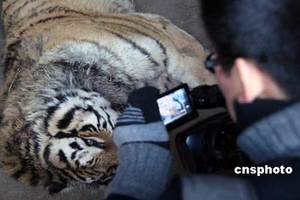The desperate tigers, which are supposed to be under the highest level of state protection in China, turned on the 12-year-old, 330-pound tiger and tore off its left leg on Saturday afternoon at the privately-owned Shenyang Glacier Zoo in Shenyang, capital of northeast China's Liaoning Province.

|
| ©China News |
| A Siberian tiger is killed on Nov. 18 by three fellow tigers in the Glacier Zoo in Shenyang, Liaoning Province due to severe lack of food this winter. |
"When the keeper arrived, the four tigers were still eating the dead body on the ground," said Li Wen Shui, deputy director of the zoo's management office.
"I was shocked, particularly as the five tigers, who were the same age, had been living together for five years. This kind of thing has never happened before," he said.
A visitor to the zoo, Ling Xia Dan, witnessed the aftermath of the attack.
"I saw the body lying on the ground with the left leg and left ear ripped off. I wouldn't have believed it was true if I hadn't seen it myself," she said.
Wen was quick to blame the killing on the zoo's financial woes.
"The zoo is in a financial crisis and we haven't been able to provide the tigers with sufficient food for the last two years.
"An adult tiger eats about 20 pounds of meat a day, but the tigers here can barely get a chicken to quench their hunger every one or two days," he admitted.
Fan Zhiyong, species program director with the WWF, laid the blame squarely on the zoo's management.
"This kind of tragedy of tiger eats tiger is unheard of. It rarely happens in the wild. It is obvious that the zoo's management should be held responsible," he said.
The zoo keeps 300 state-level endangered animals such as the white tiger, leopard and Asian elephant.
According to Wu Xi, secretary of the zoo's Communist Party committee, the carnivores need 500 kilograms of meat a day, and fish eaters, such as sea lions and seals, consume 120 kilograms offish.
But the zoo does not have the resources to match the demand. It began to struggle to feed its 2,000 animals shortly after it opened to the public in December 2000. One ravenous elephant angrily smashed through the wall of its compound last year.
Wu said the revenue gained from entrance tickets - around 1 million yuan (133,333 U.S. dollars) a year - was the zoo's only source of income and way below the expenditure.
As a result, only animals like the elephant and the giraffe have heating in their pounds. The temperature in the northeastern region has remained resolutely below zero since winter arrived a month ago.
Visitors during the winter season are sparse. The zoo was nearly forced to close this time last year until it was rescued by a local government loan of 2.05 million yuan.
Wu said the loan has run out and the zoo is lobbying for more financial assistance from the government.
But a spokesman with the municipal government of Shenyang told Xinhua that the government would not be offering any further loans to the zoo.
"We will not give the zoo any more money as the management can not repay it. But we will buy food for the animals so they no longer suffer from starvation," he said.
He Zhen, director of the local investment promotion bureau, told Xinhua he was looking for buyers for the zoo but, with the investment prospects so bleak, it could be a long search.
Life is tough for animals in many of China's zoos and tiger parks.
The Hengdaohezi Feline Breeding Center in northeast China's Heilongjiang Province is the world's largest Siberian tiger breeding base. The tiger population has grown from eight, when the park opened in 1986, to around 700.
The park has started to exercise birth control on tigers and feed them with less expensive chicken instead of beef. The center has continually bemoaned its lack of funds and earlier this year called for the legalization of the trade of tiger parts to boost its income.



Reader Comments
to our Newsletter